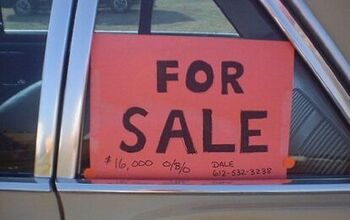Annual Edition: How to Buy a Used Car - First Contact
Used cars give automobile buyers the best possible bang for the buck– except when they don’t. As a professional dealer, I could tell you stories of used car calamities that would make public transportation seem like the only sensible option. Tales of stitched together death traps that looked as new as the day both cars were born. Cars with supposedly clean registration papers that turned out to be hotter than Peachtree Street in mid-August. Instead, I’m going to tell you how to buy a used car without getting your proverbial clock cleaned.
Finding an appropriate used car is a pretty simple business: decide what kind of car you want, research it online (especially model and brand-specific enthusiasts’ sites) and then go out and find one.
You can find a great car at a variety of sources: private, owner, independent used car dealer, used car superstores, new car dealer; even a “buy here / pay here” lot might stock a great vehicle or two (credit the law of averages). On a percentage basis, I’ve found that private owners and independent dealers offer the best bang for the buck. Conversely, your neighborhood impound lot or public auction is a no-no nadir.
When you make contact with the seller, ask for the car’s VIN (Vehicle Identification Number). That’s the government-mandated ID code welded onto the car’s chassis (and attached elsewhere), and listed on the car’s registration papers. Thank the seller for the info, tell them you’ll call them back, and hit the ‘Net.
Plug the car’s VIN number into Carfax’s or Autocheck’s on-line database. For a nominal fee, these sites will tell you if the car’s been flooded, torched, stolen, crashed, rebuilt, salvaged or had its odometer rolled back. The information on these sites is not all encompassing. But it can save you the cost of having your mechanic inspect a vehicle that is not worth your time.
Equally important, it’ll let you know if the car was a rental, a fleet vehicle or had a long series of owners (i.e. sporty models with neglectful owners are financial time bombs). Cars that have been recently owned for a short period of time may either have nasty issues that the seller may not want to disclose; such as powertrain issues and failed emissions. Or it may be that the seller is a curbstoner who makes a convenient side living by flipping cars to those who know little about them.
This due diligence must be done, but the information on these reports is far from perfect. Any damage not filed in an accident report won’t show up. Arbitration issues can also fall through the cracks. When TTAC alum Frank Williams checked an Audi he once owned, the report made no mention of the fact that Audi bought back the car under Lemon Law provisions.
To fill the holes in a used car’s mission critical history, it pays to dig a little deeper.
Contact the service department at the brand-appropriate dealership and ask the service advisor for a maintenance report. By law, dealers can’t print out the information or give the owner’s name. But they CAN verbally report a car’s service history. If you’ve got the wrong dealership, contact the seller and ask where the car was serviced.
This brings us back to your most important source of car-specific information: the seller.
After you’ve secured the VIN and done your homework, call the seller back. There are dozens of excellent questions you can ask, and one you shouldn’t: what’s the price? Avoid negotiating price for the same reason you wouldn’t bid on a house without looking inside.
Here’s how I do it:
“I like to catch up on maintenance whenever I buy a car. Can you tell me where the car was serviced, what you’ve done lately and if there’s anything else I’ll need to do in the next year or so?”
“I usually have my cars inspected at ‘x’. If I like the car, would it be OK to have it inspected?”
I always use conditional words and phrases– “Can you… would… do you know…is it possible.” It’s non-threatening, and the polite approach encourages the owner to provide additional information. It also can help you thresh out who is the genuine owner and who is the opportunist.
Thank the seller; you’ll call them back when you’re ready to see the car in person.
If confidence is still high, it’s time to determine an appropriate price. Forget Ebay, Kelly Blue Book and NADA. For popular late model used automobiles, Clearbook is the only pricing guide that matters. Edmunds,com can also be a solid cross-reference when it comes to late model vehicles.
If there aren’t any recent or enough listings, go to your local bank or credit union. Tell them you’re looking at buying a used car and ask them to print out an industry wide pricing guide called the Manheim Market Report (MMR).
The MMR lists wholesale and retail used car prices based on millions of recent transactions. Although the MMR is not for public consumption, almost all financial institutions with an auto lending department have access to this information.
Time for a bid? Nope. Time for a test drive.
Every year I plan on improving the content of this car buying series for your benefit. The world changes and with that, this series will continue to reflect what is new and important for you as a car buyer. I invite your feedback. Especially if you want share your recent used car triumphs and tragedies below.
More by Steven Lang
Latest Car Reviews
Read moreLatest Product Reviews
Read moreRecent Comments
- Dr.Nick What about Infiniti? Some of those cars might be interesting, whereas not much at Nissan interest me other than the Z which is probably big bucks.
- Dave Holzman My '08 Civic (stick, 159k on the clock) is my favorite car that I've ever owned. If I had to choose between the current Civic and Corolla, I'd test drive 'em (with stick), and see how they felt. But I'd be approaching this choice partial to the Civic. I would not want any sort of automatic transmission, or the turbo engine.
- Merc190 I would say Civic Si all the way if it still revved to 8300 rpm with no turbo. But nowadays I would pick the Corolla because I think they have a more clear idea on their respective models identity and mission. I also believe Toyota has a higher standard for quality.
- Dave Holzman I think we're mixing up a few things here. I won't swear to it, but I'd be damned surprised if they were putting fire retardant in the seats of any cars from the '50s, or even the '60s. I can't quite conjure up the new car smell of the '57 Chevy my parents bought on October 17th of that year... but I could do so--vividly--until the last five years or so. I loved that scent, and when I smelled it, I could see the snow on Hollis Street in Cambridge Mass, as one or the other parent got ready to drive me to nursery school, and I could remember staring up at the sky on Christmas Eve, 1957, wondering if I might see Santa Claus flying overhead in his sleigh. No, I don't think the fire retardant on the foam in the seats of 21st (and maybe late 20th) century cars has anything to do with new car smell. (That doesn't mean new car small lacked toxicity--it probably had some.)
- ToolGuy Is this a website or a podcast with homework? You want me to answer the QOTD before I listen to the podcast? Last time I worked on one of our vehicles (2010 RAV4 2.5L L4) was this past week -- replaced the right front passenger window regulator (only problem turned out to be two loose screws, but went ahead and installed the new part), replaced a bulb in the dash, finally ordered new upper dash finishers (non-OEM) because I cracked one of them ~2 years ago.Looked at the mileage (157K) and scratched my head and proactively ordered plugs, coils, PCV valve, air filter and a spare oil filter, plus a new oil filter housing (for the weirdo cartridge-type filter). Those might go in tomorrow. Is this interesting to you? It ain't that interesting to me. 😉The more intriguing part to me, is I have noticed some 'blowby' (but is it) when the oil filler cap is removed which I don't think was there before. But of course I'm old and forgetful. Is it worth doing a compression test? Leakdown test? Perhaps if a guy were already replacing the plugs...

































Comments
Join the conversation
This article is really on point with used car buying advice. you definitely have to be really careful when you buy used, but if you do it correctly you can end up getting a great car for less money. www.selljunkcarohio.com sell junk car ohio
That's a nice guide indeed about buying the used cars. If you guys are looking to buy quality cars, just go to www.mdkjapan.com to buy clean used Japanese cars directly from Japan and get it shipped to your destination at a very low cost.